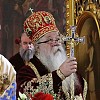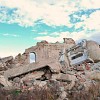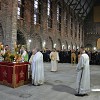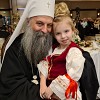St. Nicholas, Santa Claus, and the Nativity: An Interview with Metropolitan Hilarion (Alfeyev)
Archimandrite Anthony (Kapustin) demonstrated that the ancient hagiographers had allowed the interweaving of two lives: Nicholas of Myra and Nichols of Sion. It all began when, in the middle of the tenth century, someone decided to “supplement” the official life of Nicholas of Myra in Lycia written by the Greek monk Michael the Archimandrite. These two Nicholases merged into one venerated image in popular representation and later in ecclesiastical memory.
In December 2010 an interview with Metropolitan Hilarion (Alfeyev) conducted by Ivan Semenov on the subject of St. Nicholas was broadcast on the program “Church and World” on the “Russia 24” station. We offer below a translation of the transcript of the program.
Metropolitan Hilarion: On December 19 the memory of one of the most venerated saints, St. Nicholas the Wonderworker, Archbishop of Myra in Lycia, is celebrated.
Ivan Semenov: Vladyka, St. Nicholas is often referred to outside of Russia as a Russian saint. Russian Orthodox people consider him a special patron saint of Russia and pray especially to him. Nonetheless, St. Nicholas not only was never in Russia, but Russia as such did not exist in his time. How so?
Metropolitan Hilarion: St. Nicholas was the bishop of the city of Myra in Lycia (today this city is called Demre and is located in Turkey) and lived in the fourth century. Surprisingly little historical information has been preserved about him. But it is striking that this saint has been so venerated by the Church over the course of the centuries that in Russia, for example, he became the most venerated saint. There were more churches dedicated to St. Nicholas than anywhere else. It would happen that in a city with, say, forty churches, twenty of them would be dedicated to St. Nicholas. This is due to the special veneration of St. Nicholas in Russia and in ancient Rus’. This veneration came about for no other reason than that St. Nicholas played some sort of very significant role in the lives and spiritual experiences of hundreds, thousands, and millions of people. That is, people prayed to him and received an answer to these prayers. People addressed him for help, and miracles were performed. It is known, for instance, that St. Nicholas helped many people in distress at sea. He is traditionally seen as the patron saint of sailors. He generally helps people who are travelling. This is the experience not only of people in ancient times, but of modern people as well. Go into any Orthodox parish and ask people who have come to the service: how has St. Nicholas helped you and why is he so dear to you? And nearly everyone will likely relate some story from his or her life connected with the help and heavenly intercession of St. Nicholas. There are many such stories.
Ivan Semenov: Vladyka, our viewers might be surprised that, as you have mentioned, little historical evidence exists. In the West doubt has even arisen about the historicity of the figure of St. Nicholas. At the same time, contemporary historians have found confirmation of his existence, and even of his life, and we have a short report on this.
[Video clip begins]
Narrator: The following fact was established already a century and a half ago. Archimandrite Anthony (Kapustin) demonstrated that the ancient hagiographers had allowed the interweaving of two lives: Nicholas of Myra and Nichols of Sion. It all began when, in the middle of the tenth century, someone decided to “supplement” the official life of Nicholas of Myra in Lycia written by the Greek monk Michael the Archimandrite. These two Nicholases merged into one venerated image in popular representation and later in ecclesiastical memory.
Andrei Vinogradov, researcher at the Institute of World History at the Russian Academy of Science: “For a long time it was unclear how these two texts had been combined. So far I have not succeeded in finding a text in the State Historical Museum in which these pieces have been directly inserted into the material of Michael the Archimandrite. Then each copied this enriched text in his own way.”
Narrator: St. Nicholas the Bishop of Pinara and Archimandrite of Sion lived in the sixth century. Theophan and Nonna, mentioned in the lives of Nicholas the God-pleaser, were the names of the former’s parents. It was namely Nicholas of Sion who made a pilgrimage to the Holy Land. To researches, such as the Europeans Gustav Anrich, Nancy Shevchenko, and Gerardo Choffari, these are indisputable facts. Nonetheless, episodes from the life of Nicholas of Sion are still published in the lives of Nicholas the God-pleaser. These can be seen in icons of the saint: the baby standing in the baptismal font, the miracle of the cypresses, and the healing of Nonna. As for succession through the ranks of the ecclesiastical hierarchy, Nicholas of Sion was a reader, deacon, and priest, whereas Nicholas of Myra in Lycia became a bishop immediately.
Andrei Vinogradov: “He lived in his hometown of Patara as a layman and distributed money to the poor. Then by command of God he went to the city of Myra, where at that very moment he was chosen as bishop. He was the first person to enter the church. One of the bishops had had a vision that the first to enter the church was to become bishop.”
Narrator: The high forehead, eagle nose, round gray beard, and height of five and a half feet – the appearance of St. Nicholas on icons is close to his actual appearance established by anthropologists. The older the icon the more reliable it is. The anthropologists who studied the saint’s relics found confirmation of facts from his life: the person whose remains are preserved in Italy ate only vegetarian food and lived for many years in the cold and damp – Nicholas the God-pleaser spent eight years in prison. The relics preserved in Bari were studied in the 1950s. In 1987 anthropologists opened the tomb in Venice and discovered that precisely the relics lacking in Apulia are preserved there.
Andrei Vinogradov: “The people from Bari stole the relics at night. They were not able to take the smallest bones. It was these that the Venetians later took. In this way, more than four-fifths of the body has been preserved and are located in Bari and Venice.”
Narrator: Another fifth of the authentic relics are scattered throughout the world. There are too many outside of Italy for all of them to be authentic. In the future DNA analysis may help stop the spread of false relics around the world. But the next goal of scholars of St. Nicholas is to discover exactly where the saint was buried in Myra in Lycia.
Andrei Vinogradov: “There are three major versions. The Russian Church erected a monument where it considered it necessary. There are alternative versions: some people base themselves on the remnants of coffins located in the church; this is the most venerated place in the church. It may be that archeological excavations will clarify this issue.”
Narrator: But whatever discoveries scholars make, new facts from the life of the Wonderworker can only supplement his earthly image. The main thing is that faith in his miraculous intercession has continued for seventeen consecutive centuries.
[End of video clip.]
Ivan Semenov: Vladyka, the Catholic Church has begun to doubt the historicity of the saint because of the opinion that two separate historical figures were conflated in his life. How does the Russian Orthodox Church view such research? Generally speaking, can such historical research influence the hagiographical literature and the Church’s attitude to its saints?
Metropolitan Hilarion: I would say this in response: every saint lives, as it were, three lives. The first was the real life that he led on earth in a given historical period of time. Sometimes we know a great deal about this life, and sometimes we know very little. Another life of the saint is his hagiography. It is good if people who knew him, who could relate the real details of his life in this hagiography, wrote this.
Very often a life is written many centuries later and then, in fact, the life is written like an icon. That is, the life is not a verbal portrait, but rather a verbal icon of the saint. Very often the life might consist of certain stories that are common for several saints that migrate from one life to another. Therefore one should not treat these lives as entirely reliable historical sources. In just the same way we do not look at an icon as a human portrait. An icon is a certain verbal, symbolic image.
The third life of a saint is his life as experienced by those people who address him in prayer over the course of centuries. This is a very real life of the saint that we can feel through our experience. Therefore, when we are told that a saint such as St. Nicholas never existed, but we know that precisely this person, precisely this saint, has helped us many times in life – then the conversation about whether he might not have existed is for us entirely baseless. The Church’s experience is no less important than any historical or archeological evidence.
Ivan Semenov: Yes, certainly anyone who has at least some spiritual experience will value this as more important than anything else.
Metropolitan Hilarion: You know, during the Soviet era we were taught that Jesus Christ never actually existed. Meanwhile, thousands and millions of people come to Christ not as some kind of ghost or phantom, but encounter the real live person of Christ; they commune with Him in prayer; they, if you will, know Him personally. They know Him by personal experience, they meet with Him, and they commune with Him. Their communion with Christ may be the very essence of their lives. One may say the same thing about the saints. Historical evidence may be more or less reliable. There are also lives of saints written by their disciples. Then this life is, in fact, a biography.
Ivan Semenov: A biography.
Metropolitan Hilarion: A biography. But it also happens, as I said earlier, that lives are written many centuries later according to certain templates or canons, just as icons are painted. And in this case, of course, one should not expect factual reliability.
Ivan Semenov: Vladyka, to return to the figure of St. Nicholas, I’d say that there could be a fourth life, if you named three. There is also the image of Santa Claus, which is not an icon but rather a sort of picture of him. This image has been extremely commercialized in the West. Vladyka, how do you view Santa Claus? Is this a blasphemous caricature, or does something remain from faith, prayer, and the image of St. Nicholas?
Metropolitan Hilarion: Very much has been commercialized in modern Western society. Very much of that which should have a pronounced Christian meaning is essentially devoid of it – for instance, the feast of Nativity. Today not everyone in the West knows that the Nativity refers to the Nativity of Christ. The Nativity is associated with vacations, breaks, skiing, family holidays, and with the opportunity to invite relatives over or to go to visit them.
Ivan Semenov: Unfortunately, in the majority of Western languages there is no meaning relating to a birth in the word “Nativity.” The word “Christmas” does not include the idea of someone being born.
Metropolitan Hilarion: But all the same it points to Christ. Nonetheless, often this Western, commercialized, secularized Nativity is entirely devoid of any Christian component. The same thing happened with St. Nicholas. After all, this is one of those saints that is loved not only by adults, but also especially by children. So the tradition developed that St. Nicholas gives children presents on New Year’s Day. Gradually this Christian component, this understanding that St. Nicholas was a Christian bishop and ascetic, disappeared and one was left with the figure of this Santa Claus, who is no different from our own Uncle Frost.
Ivan Semenov: In this regard, our viewers ask: “Should we have children believe that in Russia there is no such thing as Santa Claus, that instead we have Uncle Frost? What do you think?”
Metropolitan Hilarion: Well, it seems to me that there should always be some element of fairy tales in childhood. If children grow up only on such programs as Time or even Church and World, then they will be deprived of an essential component of a truly human upbringing. Fairy tales are an essential part of childhood. Therefore the element of fantasy should always be preserved, and with age people will understand perfectly well which characters are real and which are fantasy.
Ivan Semenov: Some Orthodox people (as a rule, new converts) fear that we will confuse children by having them believe in Uncle Frost, who isn’t real, while believing in that which the Church believes, which is real.
Metropolitan Hilarion: You know, even adults can become confused. It’s well known that there existed in ancient Rus’, and exist now, two feasts: the “winter Nicholas” and the “summer Nicholas.” The “winter Nicholas” is celebrated on December 19, and the “summer Nicholas” is celebrated in May. So when St. Nicholas is depicted wearing a miter, people say: this is the “winter Nicholas” and when he is not wearing one he is the “summer Nicholas.” But these are folk ideas. So why should we be concerned if children have certain ideas that will pass with time?
Ivan Semenov: Our viewer Pauline asks the following question about St. Nicholas: “In what cases should one pray to this saint? When can he be of more help to others?”
Metropolitan Hilarion: I think that one can pray to St. Nicholas in all cases. I, at any rate, have often turned to him in various situations and received help. I can cite a simple example. My priestly ministry began in very poor areas of Lithuania, where I had four parishes that were not connected by any means of public transportation. Of course, then I had neither my own car nor even my own horse and cart in order to travel. In order to make it from one parish to another to perform the Liturgy, I had to travel seventy kilometers [43.5 miles] either by foot or by hitchhiking. It would happen that I’d be walking and walking – and one car would go by, then a second, and a third, and a fourth, and a fifth, with no one stopping. Then I would begin to pray to St. Nicholas, and some car would be sure to stop. Of course, one could say that this was all a coincidence. But this happened so often, and in so many different situations, that I could never claim to anyone that this was all just a coincidence. But there have been other cases when St. Nicholas really saved people from danger, or even from death.
Ivan Semenov: Vladyka, there is another miracle about which a film was recently made in Russia. This concerns the so-called “Zoe’s standing,” when a girl blasphemously invited an icon of St. Nicholas to dancer with her, and then stood frozen with this icon for many days. Can this also be considered a miracle of St. Nicholas?
Metropolitan Hilarion: I would say that the miracles of St. Nicholas are normally very kind and luminous. St. Nicholas, as a rule, saves people from harm and death, and helps them in everyday affairs. Here, of course, was something entirely different. It seems that the Lord, or perhaps St. Nicholas himself, wanted to instruct and remind people that, despite their atheistic upbringing, one should treat holy things respectfully and without blasphemy. This, apparently, should apply not only to believers, but to non-believers as well. We know that such miracles took place, but they of course were suppressed and not recorded. But now certain of these miracles are coming to light.
Dear brothers and sisters, our program dedicated to St. Nicholas is coming to an end. In conclusion, I would like to remind you of the words of St. Paul from the Epistle to the Hebrews: Let us consider one another to provoke unto love and good deeds [10:24]. I wish you all the best. May the Lord keep you all!
Translated from Russian.
|
| |||||||||||||



